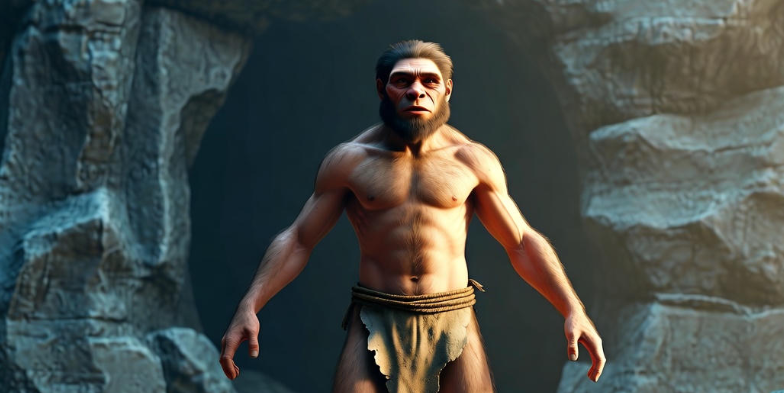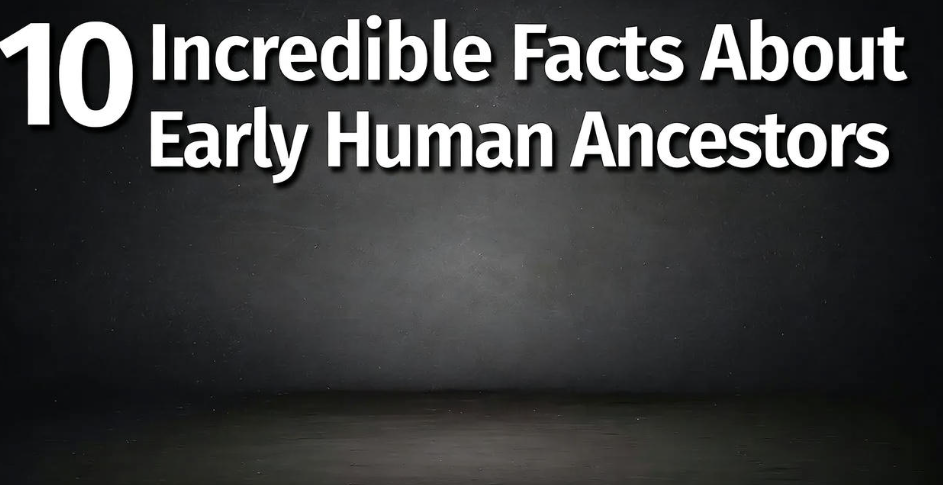Our journey as humans didn’t start with smartphones or skyscrapers—it began millions of years ago when our ancestors first stood on two feet, hunted for food, and learned to survive against impossible odds. 🧬 The story of early humans is full of mystery, courage, and incredible discoveries that show how we became who we are today. So, let’s travel back in time and explore 10 amazing facts about our earliest ancestors that will absolutely blow your mind.
1. The First Humans Weren’t Exactly “Human”
When we say “early humans,” we don’t mean people who looked like us. Our ancestors were part of a group called hominins, which included several species—like Australopithecus, Homo habilis, and Homo erectus. They walked upright, used tools, and had smaller brains compared to us, but they laid the foundation for everything we are today.
Imagine a mix between a chimpanzee and a modern human—that’s roughly how they looked. They didn’t speak like us, but they had basic communication gestures and emotional expressions. This was the beginning of human evolution’s great adventure.
| Early Ancestor | Time Period | Key Features |
|---|---|---|
| Australopithecus afarensis | 3.9 – 2.9 million years ago | Walked on two legs, small brain |
| Homo habilis | 2.4 – 1.4 million years ago | First toolmaker |
| Homo erectus | 1.9 million – 250,000 years ago | Controlled fire, long-distance travel |
| Homo neanderthalensis | 400,000 – 40,000 years ago | Strong, smart, lived in cold climates |
| Homo sapiens | 300,000 years ago – present | Modern humans, complex language & culture |
2. They Discovered Fire Before They Could Speak Properly 🔥
One of the most incredible achievements of Homo erectus was mastering fire. Imagine discovering something that not only keeps you warm but also cooks your food and scares away predators. Fire was literally the turning point in human survival.
Scientists believe early humans used natural fires—like from lightning strikes—and slowly learned to control and preserve them. Cooking food also made it easier to digest and absorb nutrients, which helped their brains grow faster. So yes, fire didn’t just keep them alive—it made them smarter.
3. They Created Tools From Stone and Bones 🪨
Before there were knives or machines, early humans used sharp stones and animal bones as their everyday tools. Homo habilis is famously known as “the handy man” because he was the first to shape stones for cutting meat, digging roots, and scraping hides.
Over time, toolmaking evolved. Later species like Homo erectus made axes and spears with more precision. This skill didn’t just make hunting easier—it gave humans an evolutionary edge.
4. Early Humans Were Amazing Travelers 🌍
You might think global travel is a modern thing—but early humans were already doing it, without GPS or maps! Fossil evidence shows that Homo erectus migrated out of Africa nearly 2 million years ago. They reached parts of Asia, Europe, and even Indonesia.
What’s truly inspiring is how they adapted to different environments—tropical forests, deserts, even icy regions. Their courage and adaptability became a part of our DNA.
5. They Communicated Without Words 💬
Before language existed, early humans relied on gestures, facial expressions, and sounds to communicate. It might sound simple, but it was powerful enough to help them hunt, share food, and care for one another.
Experts believe the first spoken words developed around 100,000 years ago, likely starting as simple sounds or calls. Imagine a mother calling her child or a hunter signaling danger—those were the first steps toward the languages we use today.
6. They Had Emotions, Families, and Love ❤️
It’s easy to think of early humans as wild and emotionless, but evidence says otherwise. Fossils show that they cared for their sick, buried their dead, and even showed affection. Neanderthals, for example, were found buried with flowers and tools—suggesting they believed in some form of afterlife.
They lived in small groups, hunted together, shared food, and protected one another. This emotional bonding laid the foundation for the social lives we live today.
7. Early Humans and Neanderthals Once Coexisted 🤝
Most people don’t know this, but Homo sapiens (modern humans) and Neanderthals lived on Earth at the same time around 60,000 years ago. In fact, they even met and interbred. Today, most non-African humans have a small percentage (1–4%) of Neanderthal DNA.
That means a little bit of Neanderthal still lives in many of us! Their genes helped us adapt to colder climates and stronger immune systems. So yes, part of us is ancient.
8. They Painted and Created Art Before Writing 🎨
Long before alphabets existed, early humans expressed themselves through cave art. Some of the oldest known paintings—like those found in France and Indonesia—are over 40,000 years old.
These paintings showed hunting scenes, animals, and handprints. Art wasn’t just decoration—it was storytelling, emotion, and culture. It’s how they shared knowledge and preserved memories long before paper existed.
9. They Survived Massive Climate Changes 🌋❄️
Our ancestors faced volcanic eruptions, ice ages, and deadly droughts—but they never gave up. Their ability to adapt to new environments made survival possible. When food ran out, they moved; when climates changed, they evolved.
This flexibility explains why humans eventually became the dominant species on Earth. We inherited that same resilience—it’s part of what makes us human.
10. The First “Communities” Were Born From Cooperation 🏕️
Early humans survived not because they were the strongest, but because they learned to work together. Sharing food, protecting the young, and hunting as a team helped them build trust and community.
Over time, this teamwork evolved into social structures—villages, tribes, and eventually civilizations. Cooperation became one of our greatest survival tools, and it’s still what keeps societies functioning today.
Interesting Comparison Table
| Human Trait | Early Humans | Modern Humans |
|---|---|---|
| Communication | Gestures, sounds | Complex languages |
| Shelter | Caves, huts | Buildings, cities |
| Food | Hunting, gathering | Agriculture, industry |
| Tools | Stone, bone | Metal, digital |
| Fire Use | Survival, cooking | Technology, energy |
| Art | Cave drawings | Modern art & media |

A Short Timeline of Human Evolution
| Period (Years Ago) | Key Milestone |
|---|---|
| 6 million | Earliest human ancestors split from chimpanzees |
| 3.5 million | Australopithecus walked upright |
| 2 million | Homo habilis used stone tools |
| 1.5 million | Homo erectus controlled fire |
| 400,000 | Neanderthals appeared |
| 300,000 | Homo sapiens evolved |
| 60,000 | Humans migrated globally |
| 10,000 | Agriculture began |
| Present | Technological age |
The Human Spark 🔆
What truly separated early humans from all other animals was curiosity—the desire to know, explore, and improve. That same curiosity led us from using stones to creating smartphones.
Our ancestors weren’t just survivors; they were innovators, artists, travelers, and dreamers. Each discovery they made—fire, tools, art—brought us closer to who we are today. Every step they took, every tool they carved, was a whisper of progress that echoes even now.
FAQs About Early Human Ancestors
Q1: Who was the first human ancestor?
The earliest known ancestor in our human lineage is Sahelanthropus tchadensis, who lived about 7 million years ago in Africa. It’s believed to be one of the first species to walk upright.
Q2: Did early humans and dinosaurs live together?
No! Dinosaurs became extinct around 65 million years ago, while humans appeared only about 6 million years ago. There’s a huge time gap between the two.
Q3: How did early humans survive without modern tools?
They used sharp stones, wooden spears, and bone tools for hunting and defense. Teamwork and adaptability helped them survive harsh environments.
Q4: What caused Neanderthals to disappear?
Climate changes, competition with Homo sapiens, and possible interbreeding led to their extinction around 40,000 years ago.
Q5: Why is Africa called the “Cradle of Humankind”?
Because the oldest fossils of early humans have been found in Africa, suggesting that all humans originally came from there.
Final Thoughts 💭
The story of early human ancestors isn’t just about evolution—it’s about courage, creativity, and survival. From sparks of fire to spoken words, from stone tools to space travel, our journey has been extraordinary.
Every time you light a candle, share a story, or help someone—you’re carrying forward the same spirit that kept our ancestors alive. They were the first dreamers, and we are their living legacy. 🌍✨
